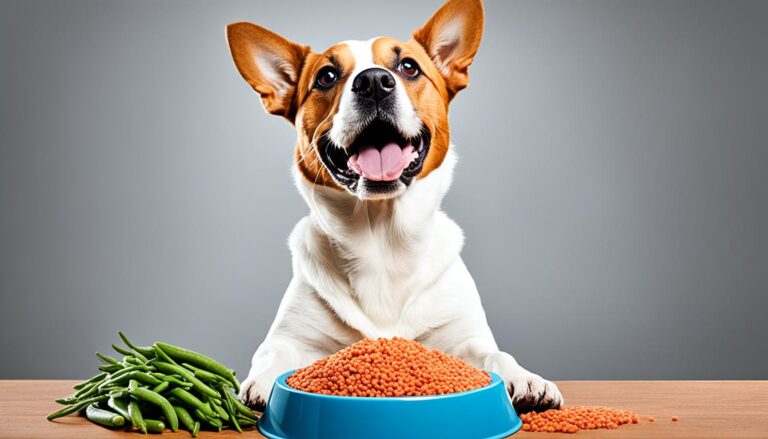Nutrition Strategies for Dogs with Cushing’s Disease

Did you know that 80-85% of Cushing’s disease in dogs comes from pituitary tumors? This fact shows how vital it is to understand and manage this condition. As a pet owner, I’ve found that the right diet is key for dogs with Cushing’s disease, also known as hyperadrenocorticism.
There’s no single cushing’s disease dog diet that works for all. But, customizing your dog’s meals can greatly improve their health. In this article, we’ll look at how to manage canine Cushing’s syndrome through diet.
We’ll cover important nutrition topics for dogs with Cushing’s disease. This includes protein needs, managing fat, and more. I’ll also suggest foods to avoid and share tips for meal planning and controlling portions. By the end, you’ll know how to help your dog stay healthy with the right nutrition.
Key Takeaways
80-85% of Cushing’s disease in dogs is caused by pituitary tumors
Nutritional therapy can support overall health in dogs with Cushing’s disease
Dog food for Cushing’s should be less than 12% fat and 8-17% crude fiber
Highly digestible protein sources are a must in a Cushing’s disease diet
Low-sodium diets help maintain normal blood pressure in affected dogs
Regular vet check-ups are necessary to monitor and adjust the diet plan
Understanding Cushing’s Disease in Dogs
Cushing’s disease is a complex endocrine disorder that affects many dogs especially as they age. It can ruin a dog’s life. Nutrition is key to managing it. Let’s talk about Cushing’s disease and how it affects our fur babies.
Definition and Types of Cushing’s Disease
Cushing’s disease, or hyperadrenocorticism, is a hormonal disorder. It’s caused by too much cortisol in dogs. There are two types:
Pituitary-dependent: This is 80-85% of the cases, caused by a tumor in the pituitary gland.
Adrenal-dependent: This is 15-20% of the cases, caused by tumors in the adrenal glands.
Common Symptoms and Diagnosis
You need to know the signs of Cushing’s disease for early diagnosis. Common symptoms are:
-
Excessive thirst and urination
Increased appetite
Pot-bellied appearance
Hair loss
Skin problems
To diagnose, blood tests, urine analysis and hormone tests are used. The ACTH stimulation test is one of them.
Impact on Dog’s Health and Metabolism
Cushing’s disease affects a dog’s metabolism. It changes how they process fats, proteins and carbs. So a special diet is needed. Elevated cortisol dog food must be balanced to manage these changes.

Creating a feeding plan for dogs with Cushing’s disease is important. It helps manage symptoms and health. Remember every dog is different. Work with your vet to find the right plan for your pup.
The Importance of Diet in Managing Cushing’s Disease
Diet is key to managing Cushing’s disease in dogs. A balanced diet can ease symptoms and improve their life. Tailor the diet to their needs when dealing with hormone imbalances.

For dogs with pituitary tumors a low fat diet is best. This helps control high cortisol levels which can increase cholesterol and triglycerides. Moderate fiber and highly digestible protein is key to balancing the disease.
When creating a meal plan for dogs with adrenal tumors you need to support multiple organs. These include the adrenal glands, pituitary gland, hypothalamus, liver, kidneys, skin, fur, digestive tract and immune system. Vitamin C and B5 are important for the adrenal glands. Dandelion root is great addition to a dogs diet and helps with adrenal gland function. Avoid high fat, sugary, processed and high sodium foods. The right diet can make a big difference for dogs with Cushing’s disease.
| Nutrient | Importance | Food Sources |
|---|---|---|
| Protein | Supports muscle maintenance | Lean meats, fish |
| Fiber | Aids digestion | Vegetables, whole grains |
| Omega-3 Fatty Acids | Anti-inflammatory effects | Fish oil, flaxseed |
| Vitamin C | Restores adrenal function | Fruits, vegetables |
| Vitamin B5 | Supports adrenal health | Organ meats, eggs |
Dandelion root is good for a dog’s adrenal gland. Avoid high fat, sugar, processed and high sodium foods. The right diet can help dogs with Cushing’s.
Key Nutritional Considerations for Dogs with Cushing’s Disease
Creating the right diet for dogs with Cushing’s is key. Focus on the right nutrients for your pet.
Protein Requirements and Sources
High quality protein is important for hyperadrenocorticism dogs. I recommend muscle meat, organ meat and egg whites. These will keep your dog’s muscles strong which is important for Cushing’s patients.
Fat Content and Management
For Cushing’s dogs keep fat low. Less than 12% fat in their diet will prevent weight gain. Healthy fats like omega-3’s are good for them too.
Carbohydrate Considerations
It’s important to limit carbs in a Cushing’s disease dog diet. Dogs often have trouble with insulin resistance. So, choose low-glycemic carbs to keep their blood sugar stable.
Fiber Importance
Aim for 8-17% crude fiber in your dog’s diet. This can help with digestive issues related to Cushing’s disease.

Every dog is different. While these tips are helpful, it’s best to work with your vet. They can create a diet plan that’s right for your dog with Cushing’s disease.
Cushing’s Disease Dog Diet: Recommended Foods and Ingredients
Creating a special diet for dogs with Cushing’s disease is key. It should have lots of protein, less fat, and fewer carbs. This helps keep your dog healthy.

For protein choose lean meats like chicken, turkey and fish. These keep muscles strong without adding weight to your dog. Eggs and low fat dairy can be added in small amounts.
For carbs choose easy to digest foods like sweet potatoes and brown rice. Add veggies like broccoli, carrots and green beans for nutrients and fiber. These are good for your dog’s gut and blood sugar control.
| Food Category | Recommended Options | Benefits |
|---|---|---|
| Protein Sources | Chicken, Turkey, Fish, Eggs | Muscle maintenance, Weight management |
| Carbohydrates | Sweet Potatoes, Brown Rice | Digestive support, Blood sugar control |
| Vegetables | Broccoli, Carrots, Green Beans | Nutrient-rich, Fiber source |
| Supplements | Fish Oil, Dandelion Root | Anti-inflammatory, Liver support |
Fish oil can help reduce inflammation. Some weight control or senior dog diets might work if they fit your dog. Always talk to a vet before changing your dog’s diet big time.
Foods to Avoid in a Cushing’s Disease Diet Plan
When dealing with a pituitary or adrenal tumour in dogs, knowing what to avoid is key. Here are some important tips for managing hormone imbalance pet nutrition in dogs with Cushing’s disease.
High-Sodium Foods
Too much sodium can exacerbate Cushing’s symptoms. Avoid canned or bagged foods with more than 100mg of sodium per serving. This will keep blood pressure in check and prevent weight gain in dogs with Cushing’s disease.
High-Fat Options
Fatty foods can be tough on your dog’s system. Limit high protein, fatty meats that will overload the kidneys. Choose lean proteins for a balanced diet for pituitary tumours in dogs.
Excessive Carbohydrates
Simple sugars and white flour can cause insulin resistance. Avoid foods with corn syrup and choose low glycemic complex carbs for your adrenal tumor dog meal plan.
| Food Type | Why Avoid | Healthier Alternative |
|---|---|---|
| High-sodium treats | Exacerbates hypertension | Low-sodium, whole food treats |
| Fatty meats | Strains kidneys, promotes weight gain | Lean proteins (chicken, fish) |
| Simple carbs (white flour) | Increases insulin resistance risk | Complex carbs (sweet potatoes, brown rice) |
A balanced diet is key to managing hormone imbalance in pets.

Meal Planning and Portion Control for Cushingoid Dogs
Managing a cushing’s disease dog diet means meal planning and portion control. Dogs with hyperadrenocorticism need special nutrition to manage symptoms and stay at a healthy weight.

For dogs with canine cushing’s syndrome I split their daily food into smaller meals. This keeps blood sugar stable and reduces hunger. They get very hungry.
To get the right portion sizes, I use measuring cups or a kitchen scale. The size of the portions depends on the dog’s weight, how active they are, and how severe their condition is. Talking to a vet is key to figuring out how many calories your dog needs.
| Dog Size | Meals per Day | Portion Size (% of Daily Intake) |
|---|---|---|
| Small (under 20 lbs) | 3-4 | 25-33% |
| Medium (20-50 lbs) | 2-3 | 33-50% |
| Large (over 50 lbs) | 2 | 50% |
Dogs with Cushing’s drink more water and go to the bathroom more. I make sure fresh water is always available and watch how much they drink. By planning meals this way I’ve seen big improvements in how they feel and their weight.
Supplementation Strategies for Dogs with Cushing’s Disease
Managing a cushingoid dog meal plan means using supplements. These can help balance the diet and tackle health issues linked to this condition.
Essential Vitamins and Minerals
Dogs with Cushing’s may lose muscle and bone strength. I suggest calcium and vitamin D supplements for bone health. Vitamins C and E help fight oxidative stress, which dogs with high cortisol levels often face.
Omega-3 Fatty Acids
Omega-3s are crucial for lowering inflammation and keeping the skin healthy in dogs with Cushing’s. I add fish oil to their food to give them these important fatty acids.
Antioxidants
Antioxidants boost the immune system of dogs with this condition. I add foods high in antioxidants to their diet to fight infections.
Here’s a helpful table of recommended supplements for dogs with Cushing’s disease:
| Supplement | Benefits | Food Sources |
|---|---|---|
| Omega-3 Fatty Acids | Reduces inflammation, supports skin health | Fish oil, flaxseed |
| Probiotics | Aids gut health | Yogurt, kefir |
| Milk Thistle | Supports liver function | Supplement form |
| Glucosamine with Chondroitin | Supports joint health | Supplement form |
Each dog is different, and a vet can give the best advice for your pet.
Hydration and Water Intake Management
For Cushing’s dogs, hydration is key. They drink more and pee more so managing their water is a big part of their diet. I always stress the importance of clean fresh water in their diet.
For Cushing’s dogs I recommend many water bowls or even water fountains. Wet or moistened food can also help them drink more which is great for dry kibble eaters.
Monitoring how much water they drink is important to avoid overhydration. This can cause electrolyte problems. Cushing’s dogs can get dehydrated easily especially when it’s hot or after they exercise. Look for signs like dry nose, panting, feeling tired and thick saliva.
| Hydration Tips | Benefits |
|---|---|
| Use multiple water bowls | Encourages more frequent drinking |
| Add moisture to dry food | Increases overall fluid intake |
| Clean water bowls regularly | Prevents bacterial growth |
| Monitor water intake | Helps maintain proper hydration balance |
Keeping your dog hydrated is key to managing Cushing’s disease. By using these tips in your pet’s nutrition plan, you can make them more comfortable and happy.
Monitoring and Adjusting the Diet Plan
Keeping an eye on my dog is key when managing a cushing’s disease dog diet. It’s not just about setting up a meal plan and forgetting about it. Regular check-ins and adjustments are crucial.
Regular Veterinary Check-ups
I go to the vet every 3 months. During those appointments we check cortisol levels and overall health. We fine tune the hyperadrenocorticism canine nutrition plan as needed.
Weight Management
I weigh my dog daily. I’ve found that dogs at a healthy weight live longer. I weigh my pup weekly and adjust portions if I see any changes. For weight loss I use vet prescribed foods that are higher in protein and fiber and lower in fat.
Symptom Observation
I keep a daily log of my dog’s symptoms, appetite, thirst and energy levels. This way I can catch any changes quickly. If I see anything off I don’t hesitate to call my vet. They may suggest tweaks to the canine cushing’s syndrome diet or medication.
Remember managing Cushing’s is a team effort between you, your dog and your vet. Stay vigilant, be ready to adjust and celebrate the small wins!
Conclusion
Nutrition plays a big role in helping dogs with Cushing’s. A special diet can make your dog feel better. You have to balance proteins, fats and carbs to manage symptoms.
Choose foods low in sodium and fat high in fiber for your dog. This will help with weight and liver strain. Regular vet visits are key to check on your dog and adjust their diet if needed.
Adding omega-3’s and antioxidants will help your dog. Keeping your dog hydrated is also important. With the right diet your dog can live a happier healthier life with Cushing’s.






